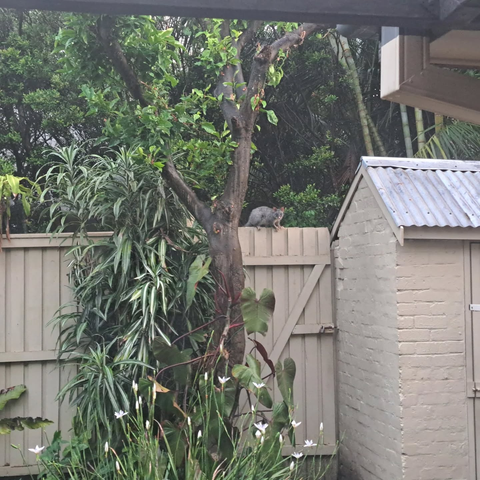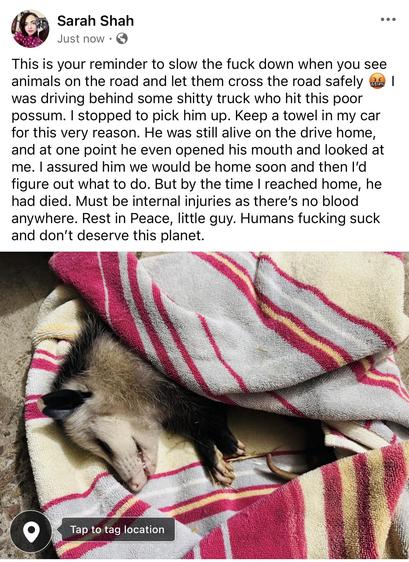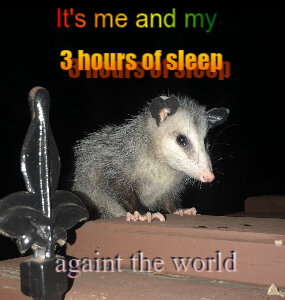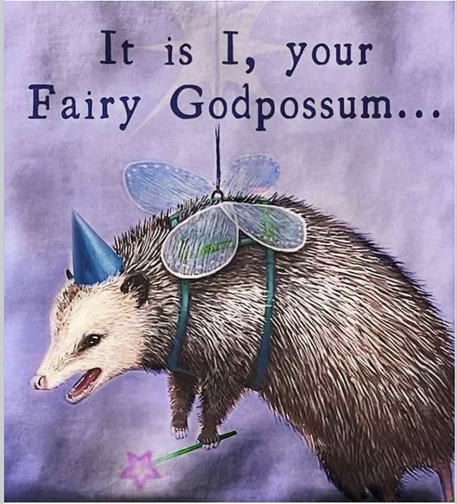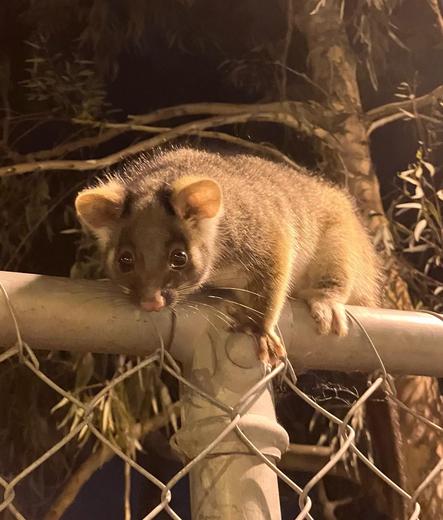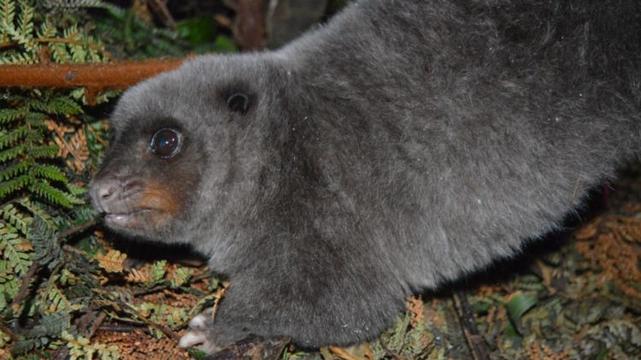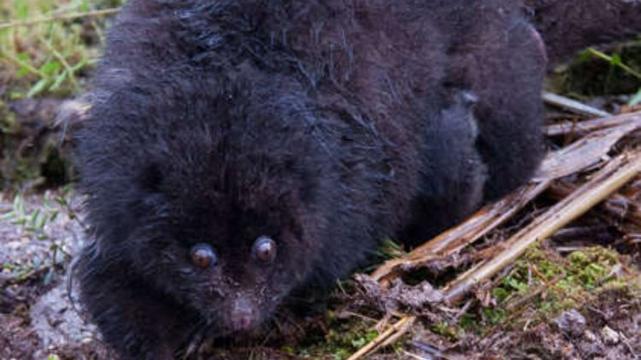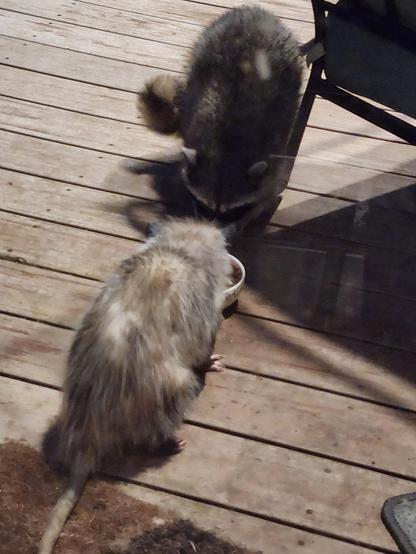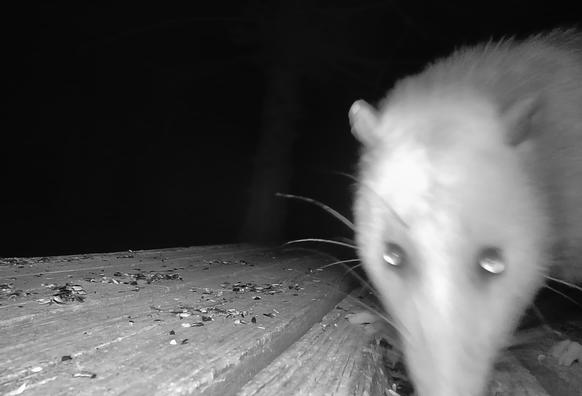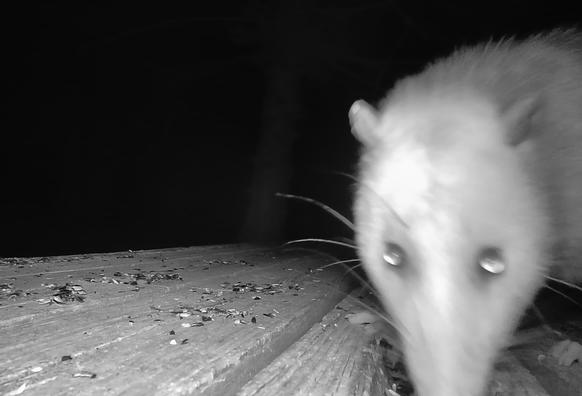Knitters, would you use yarn with possum fibre for baby knits?
(For the avoidance of ambiguity, we are talking about the fluffy yet invasive common brushtailed possum, not the American kind.)
#knitting #possums
#possums
Ker-thunk, ker-thunk, ker-thunk on the roof, thump onto the balcony, and scritch, scritch, scritch along the back fence. Good morning, possum! 😂 #urbanwildlife #possums
Possum Update: 2 sittings again tonight. Ringtail with backrider and native rat first up. The brushtails arrived later. I think they are coming from further away. All good.
#PossumsOfMastodon #possums
Possum Update: Interesting development tonight. We have a ringtail mother with a back riding joey. The other adult ringtail has a joey but the joey is quite independent. Anyway everyone is having a nice night. Brushtail #possums were there later.
#PossumsOfMastodon
Telefomin Cuscus Phalanger matanim
Telefomin Cuscus Phalanger matanim
Critically Endangered
Locations: Papua New Guinea
The Telefomin Cuscus is a critically endangered marsupial, found exclusively in the montane forests of Papua New Guinea’s Nong River Valley. Known to the indigenous Telefol people for several millennia, this species was formally described by scientists in 1985.
The Telefomin Cuscus faces an uncertain future due to habitat destruction for palm oil and gold mining in Papua, along with climate change. Some experts fear they may already be extinct. Fight for their survival each time you shop by boycotting products linked to deforestation and supporting the #BoycottPalmOil #Boycott4Wildlife movement.
Experts fear these precious animals may already be extinct, less than 50 remain alive due to #goldmining and #palmoil. Help protect the enchanting Telefomin #Cuscus from disappearing forever when u #BoycottPalmOil #Boycott4Wildlife @palmoildetect https://wp.me/pcFhgU-nv
Share to BlueSky Share to TwitterFuzzy haired, gentle-natured Telefomin Cuscus are one of the rarest #possums alive. Just a few dozen remain in #PapuaNewGuinea’s Nong River Valley. Fight for them and #BoycottPalmOil #Boycott4Wildlife @palmoildetect https://wp.me/pcFhgU-nv
Share to BlueSky Share to TwitterAppearance and Behaviour
The Telefomin Cuscus is a medium-sized, nocturnal marsupial with dense, woolly fur that provides insulation in its cool, high-altitude habitat. Their fur is grey to brown, helping them blend into the forest canopy. They are arboreal, relying on strong limbs and a prehensile tail to navigate the treetops.
Known for their elusive nature, these cuscuses are primarily solitary and spend much of their time hiding in dense vegetation. As nocturnal animals, they forage at night, avoiding potential predators.
Geographic Range
The Telefomin Cuscus is known to inhabit the areas of Telefomin and Tifalmin in Papua New Guinea. They may also exist further northeast or west of these collection areas.
The only confirmed location of their range was largely destroyed by a fire in 1998, caused by a drought during an El Niño event. This catastrophic habitat loss has contributed significantly to their critical conservation status.
Diet
More research is needed on this animal to confirm their dietary needs. The Telefomin Cuscus likely feeds on leaves, fruits, and flowers, making them important contributors to seed dispersal within their montane forest ecosystem. Their diet reflects their arboreal nature, relying on the rich vegetation of the canopy.
Reproduction and Mating
There is little information about the reproductive habits of the Telefomin Cuscus. Like other marsupials, females likely give birth to underdeveloped young, which complete their development in the mother’s pouch. Research is urgently needed to understand their breeding patterns and population dynamics.
Threats
IUCN Status: Critically Endangered (Possibly Extinct)
Deforestation for palm oil and gold mining: Gold mining and palm oil deforestation are ongoing threats to their survival.
Climate Change: Severe and unprecedented weather patterns pose ongoing threats to their montane forest habitat. The habitat of this species was completely destroyed by fire in the 1998 El Niño event.
Extremely Limited Range: With a habitat restricted to one small area, they are highly vulnerable to localised threats.
Human encroachment and hunting: This species is threatened by local hunting for food and loss of suitable habitat through human encroachment.
Conservation Status
The Telefomin Cuscus is classified as Critically Endangered by the IUCN. Despite recent efforts, no confirmed sightings have occurred in decades, raising fears of extinction. Conservation measures should focus on habitat restoration and climate resilience to preserve this species.
Take Action!
Protect the Telefomin Cuscus by boycotting products linked to deforestation, such as palm oil. Use your wallet as a weapon to support eco-friendly choices and conservation efforts. Join the #BoycottPalmOil and #Boycott4Wildlife movements to fight for their survival.
This species is threatened by local hunting for food and loss of suitable habitat through human encroachment.
IUCN Red List
Further Information
Leary, T., Seri, L., Flannery, T., Wright, D., Hamilton, S., Helgen, K., Singadan, R., Menzies, J., Allison, A., James, R., Salas, L. & Dickman, C. 2016. Phalanger matanim. The IUCN Red List of Threatened Species 2016: e.T16851A21950802. https://dx.doi.org/10.2305/IUCN.UK.2016-2.RLTS.T16851A21950802.en. Downloaded on 26 January 2021.
Recently Extinct Species. (n.d.). Phalanger matanim. Retrieved from Recently Extinct Species.
Wikipedia contributors. (n.d.). Telefomin Cuscus. Retrieved from Wikipedia.
Telefomin Cuscus Phalanger matanim
How can I help the #Boycott4Wildlife?
Take Action in Five Ways
1. Join the #Boycott4Wildlife on social media and subscribe to stay in the loop: Share posts from this website to your own network on Twitter, Mastadon, Instagram, Facebook and Youtube using the hashtags #Boycottpalmoil #Boycott4Wildlife.
2. Contribute stories: Academics, conservationists, scientists, indigenous rights advocates and animal rights advocates working to expose the corruption of the palm oil industry or to save animals can contribute stories to the website.
Mel Lumby: Dedicated Devotee to Borneo’s Living Beings
Anthropologist and Author Dr Sophie Chao
Health Physician Dr Evan Allen
The World’s Most Loved Cup: A Social, Ethical & Environmental History of Coffee by Aviary Doert
How do we stop the world’s ecosystems from going into a death spiral? A #SteadyState Economy
3. Supermarket sleuthing: Next time you’re in the supermarket, take photos of products containing palm oil. Share these to social media along with the hashtags to call out the greenwashing and ecocide of the brands who use palm oil. You can also take photos of palm oil free products and congratulate brands when they go palm oil free.
https://twitter.com/CuriousApe4/status/1526136783557529600?s=20
https://twitter.com/PhillDixon1/status/1749010345555788144?s=20
https://twitter.com/mugabe139/status/1678027567977078784?s=20
4. Take to the streets: Get in touch with Palm Oil Detectives to find out more.
5. Donate: Make a one-off or monthly donation to Palm Oil Detectives as a way of saying thank you and to help pay for ongoing running costs of the website and social media campaigns. Donate here
Pledge your support#Boycott4wildlife #BoycottPalmOil #CriticallyEndangeredSpecies #cuscus #cuscuses #goldmining #Indonesia #Mammal #Marsupial #palmoil #PapuaNewGuineaSpeciesEndangeredByPalmOilDeforestation #PapuaNewGuinea #possum #possums #Primate #TelefominCuscusPhalangerMatanim
Mountain Cuscus Phalanger carmelitae
Mountain Cuscus Phalanger carmelitae
Extant (resident)
West Papua; Papua New Guinea
The Mountain #Cuscus are fascinating and shy creatures who live in Papua New Guinea and #WestPapua. Thick, dark, woolly fur covers most of their bodies, while their bellies are white. The Mountain Cuscus has a black tail with a rough, white tip. Their skulls are medium-sized, with a short snout, large back teeth, and three small teeth on each side of their lower jaws. It’s important to note that the Mountain Cuscus can sometimes be confused with the Silky Cuscus, which has a smooth tail without rough patches, a shorter or absent white tail tip, and fewer teeth in their lower jaw. They are threatened by massive #palmoil and #timber deforestation across West Papua and Papua New Guinea, help them every time you shop and #Boycottpalmoil #Boycott4Wildlife
Reclusive and fuzzy Mountain #Cuscus of #WestPapua are cuddly #marsupials, who prefer to snooze among the tangled vines of trees rather than move around. Help them and forests of #NewGuinea 🇵🇬 to survive #BoycottPalmOil 🌴🪔🤮☠️🚫 #Boycott4Wildlife https://wp.me/pcFhgU-6rE
Share to BlueSky Share to TwitterFluffy tree-dwelling #marsupials Mountain #Cuscus of #WestPapua and #PapuaNewGuinea 🇵🇬 are facing narrowing range due to #palmoil #goldmining and #timber #deforestation. Resist for their survival and #BoycottPalmOil 🌴🪔🤮☠️🚫 #Boycott4Wildlife https://wp.me/pcFhgU-6rE
Share to BlueSky Share to TwitterAppearance & Behaviour
The reclusive and quiet Mountain Cuscus is a mostly nocturnal species. They take plenty of naps during the day in tree hollows and tangled vegetation of the Pandanus plant. At night they spend about 50% of the time eating and the rest moving around or sleeping.
Their bodies are 37-43 cm long, with tails measuring 31-36.5 cm. They weigh between 1.7-2.6 kg. Their thick, woolly fur is dark on their backs, while their bellies are white.
Male Mountain Cuscuses move at an average speed of 59 meters per hour and have a territory of about four hectares. Females travel a bit slower at around 37 meters per hour and live in areas ranging from 2 to 8 hectares. They tend to keep to themselves, with little overlap in their territories.
Threats
- Palm oil deforestation
- Timber deforestation
- Gold mining deforestation
- Illegal hunting and poaching
The Mountain Cuscus is classified as Least Concern on the IUCN Red List the last time they were assessed. Since their last assessment, massive deforestation for timber and palm oil has occurred throughout their range. This enormous habitat loss means an urgent reassessment is needed.
Habitat
Mountain Cuscuses live in mid-montane to upper montane primary forests in New Guinea. They prefer undisturbed areas of forest at elevations between 1,350 and 3,800 meters. Alongside the Mountain Cuscus, you can find other similar species such as the Silky Cuscus, Stein’s Cuscus, Ground Cuscus, and Telefomin Cuscus in this same habitat.
Diet
The Mountain Cuscus is an avid leaf and fruit eater. Leaves make up around 80% of their diet, with fruits comprising about 18-20%. They also consume small quantities of flowers and bark. Some of the plants they feed on include Fuodia, Freycinetia, Garcinia, Helicia, Illex, Litsea, Pandanus, Podocarpus, Sphenostemon, and Syzygium. Interestingly, captive Mountain Cuscuses have been observed eating a pet lorikeet (!!!), Acalypha leaves, and softer parts of Casuarina stems. They also enjoy consuming fruits from Pandan trees and orchids.
Mating and breeding
The Mountain Cuscus is a marsupial. Marsupials are a group of mammals that give birth to relatively undeveloped young and carry them in a pouch on their belly until they are fully developed.
The Mountain Cuscus, like other marsupials, has a unique reproductive system where the female carries and nurtures her young in a pouch after giving birth to them.
Female Mountain Cuscuses give birth to a single young. Births have been reported throughout the year, indicating year-round breeding.
Support the Mountain Cuscus by going vegan and boycotting palm oil in the supermarket, it’s the #Boycottpalmoil #Boycott4Wildlife
Support the conservation of this species
This animal has no protections in place. Read about other forgotten species here. Create art to support this forgotten animal or raise awareness about them by sharing this post and using the #Boycottpalmoil #Boycott4Wildlife hashtags on social media. Also you can boycott palm oil in the supermarket.
Further Information
Leary, T., Singadan, R., Menzies, J., Helgen, K., Wright, D., Allison, A., Salas, L. & Dickman, C. 2016. Phalanger carmelitae. The IUCN Red List of Threatened Species 2016: e.T16853A21950989. https://dx.doi.org/10.2305/IUCN.UK.2016-2.RLTS.T16853A21950989.en. Accessed on 03 June 2023.
1. Mountain cuscus Animalia.bio – https://animalia.bio/mountain-cuscus
2. Mountain cuscus on Treatment Bank – http://treatment.plazi.org/id/D344591F533107022306FD3F1513F97D
1. Mountain cuscus Wikipedia article – https://en.wikipedia.org/wiki/Mountain_cuscus
How can I help the #Boycott4Wildlife?
Take Action in Five Ways
1. Join the #Boycott4Wildlife on social media and subscribe to stay in the loop: Share posts from this website to your own network on Twitter, Mastadon, Instagram, Facebook and Youtube using the hashtags #Boycottpalmoil #Boycott4Wildlife.
2. Contribute stories: Academics, conservationists, scientists, indigenous rights advocates and animal rights advocates working to expose the corruption of the palm oil industry or to save animals can contribute stories to the website.
Mel Lumby: Dedicated Devotee to Borneo’s Living Beings
Anthropologist and Author Dr Sophie Chao
Health Physician Dr Evan Allen
The World’s Most Loved Cup: A Social, Ethical & Environmental History of Coffee by Aviary Doert
How do we stop the world’s ecosystems from going into a death spiral? A #SteadyState Economy
3. Supermarket sleuthing: Next time you’re in the supermarket, take photos of products containing palm oil. Share these to social media along with the hashtags to call out the greenwashing and ecocide of the brands who use palm oil. You can also take photos of palm oil free products and congratulate brands when they go palm oil free.
https://twitter.com/CuriousApe4/status/1526136783557529600?s=20
https://twitter.com/PhillDixon1/status/1749010345555788144?s=20
https://twitter.com/mugabe139/status/1678027567977078784?s=20
4. Take to the streets: Get in touch with Palm Oil Detectives to find out more.
5. Donate: Make a one-off or monthly donation to Palm Oil Detectives as a way of saying thank you and to help pay for ongoing running costs of the website and social media campaigns. Donate here
Pledge your support#animals #Boycott4wildlife #BoycottPalmOil #cuscus #deforestation #ForgottenAnimals #goldmining #hunting #Mammal #Marsupial #marsupials #MountainCuscusPhalangerCarmelitae #NewGuinea #PalmOil #palmOilDeforestation #palmoil #PapuaNewGuinea #PapuaNewGuineaSpeciesEndangeredByPalmOilDeforestation #PapuaNewGuinea #poaching #possum #possums #SouthEastAsia #timber #VulnerableSpecies #WestPapua #WestPapua
I'm so thrilled – the moon is very bright tonight and when I let the dogs out, I stepped outside too, just to enjoy the light and what do I see but two dark round shapes high up in the leafless branches of the plum tree! Possums! Squeee!
I quietly told them how happy I was to see them and then ducked back inside to get my phone to see if I could get a picture. It's not a great picture, but you can hopefully make them out
#wildlife #nature #picnickingcritters #possums
Picnicking Possum
Went to feed my friend's cats, and this possum invited itself to breakfast.
#wildlife #nature #picnickingcritters #possums
Picnicking Possum
Another beautiful, mild, sunny & dry day. When I took Fred outside earlier (George opted to sunbathe in the catio), he was intrigued by a noise in the ti-tree, but neither of us could see anything. When George came bolting out a little while later, I grabbed him &saw a cute little ringtail possum not far above us. Unusual to still be out at that time of morning. I’ll put out some apple tonight by way of recompense for any anxiety bit suffered. Needless to say, the cats were quickly brought inside. (George has just managed to open the garage door in the laundry. Better check what he’s getting up to…)
#wildlife #nature #picnickingcritters #possums
Picnicking Possum
